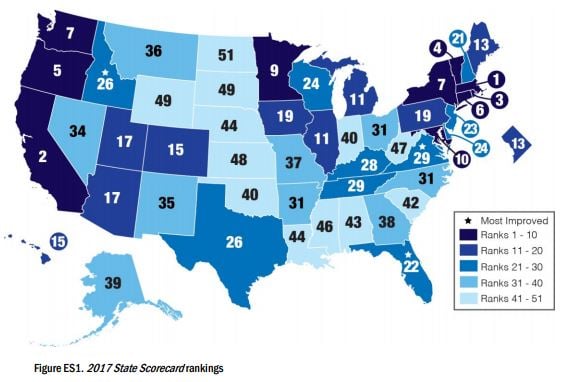
In 2016, U.S. utilities invested about $7.6 billion in energy efficiency programs and saved approximately 25.4 million megawatt-hours (MWh) of electricity. The U.S. Energy Information Administration (EIA) reported that in July of this year, the average cost of a kilowatt-hour in the United States was 13.12 cents, or $131.20 per MWh. That’s a savings of $3.33 billion.
Energy efficiency efforts vary among states, but in 2016 about half the states reported saving more as a result of energy efficiency programs than they did in 2015.
The American Council for an Energy-Efficient Economy (ACEEE) just published its annual “State Energy Efficiency Scorecard” that ranks the 50 states and the District of Columbia in six categories: utility programs, transportation, building energy codes, combined heat and power, state initiatives and appliance standards. Scores are assigned in a range of 1 to 50.
The 10 states with the highest (best) energy efficient scores last year were:
- Massachusetts: 44.5
- California: 42.0
- Rhode Island: 41.5
- Vermont: 39.0
- Oregon: 36.5
- Connecticut: 35.5
- New York: 34.5
- Washington: 34.5
- Minnesota: 33.0
- Maryland: 31.0
In only one state, Maryland, did the cost of a kilowatt hour fall in the period between July 2016 and July 2017.
The 10 states with the lowest energy efficiency scores were:
- North Dakota: 3.5
- Wyoming: 5.0
- South Dakota: 5.0
- Kansas: 6.0
- West Virginia: 6.5
- Mississippi: 7.5
- Nebraska: 8.5
- Louisiana: 8.5
- Alabama: 9.0
- South Carolina: 9.5
Only Nebraska showed a year-over-year decline in the price of a kilowatt-hour.
Here’s a map with scores for all 50 states and D.C.

Source: ACEEE
The full ACEEE 2017 Scorecard is available at the organization’s website.
Take This Retirement Quiz To Get Matched With A Financial Advisor (Sponsored)
Take the quiz below to get matched with a financial advisor today.
Each advisor has been vetted by SmartAsset and is held to a fiduciary standard to act in your best interests.
Here’s how it works:
1. Answer SmartAsset advisor match quiz
2. Review your pre-screened matches at your leisure. Check out the
advisors’ profiles.
3. Speak with advisors at no cost to you. Have an introductory call on the phone or introduction in person and choose whom to work with in the future
Take the retirement quiz right here.
Thank you for reading! Have some feedback for us?
Contact the 24/7 Wall St. editorial team.
 24/7 Wall St.
24/7 Wall St.

